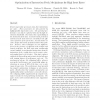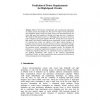1994 search results - page 87 / 399 » The design of a high performance low power microprocessor |
ISCA
1995
IEEE
14 years 13 days ago
1995
IEEE
Recent superscalar processors issue four instructions per cycle. These processors are also powered by highly-parallel superscalar cores. The potential performance can only be expl...
EVOW
2000
Springer
14 years 15 days ago
2000
Springer
Modern VLSI design methodologies and manufacturing technologies are making circuits increasingly fast. The quest for higher circuit performance and integration density stems from f...
ISSS
2002
IEEE
14 years 1 months ago
2002
IEEE
Adding a small loop cache to a microprocessor has been shown to reduce average instruction fetch energy for various sets of embedded system applications. With the advent of core-b...
VTC
2007
IEEE
14 years 3 months ago
2007
IEEE
Abstract— We analyze the performance of multiple-input multiple-output (MIMO) systems employing orthogonal space-time block codes (STBC) in general Nakagami-m fading channels wit...
CODES
2009
IEEE
14 years 3 months ago
2009
IEEE
Time redundancy (rollback-recovery) and hardware redundancy are commonly used in real-time systems to achieve fault tolerance. From an energy consumption point of view, time redun...


